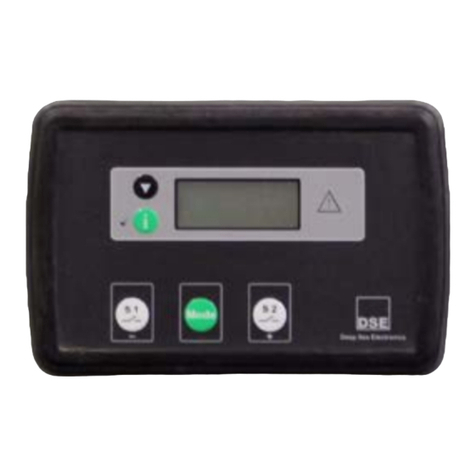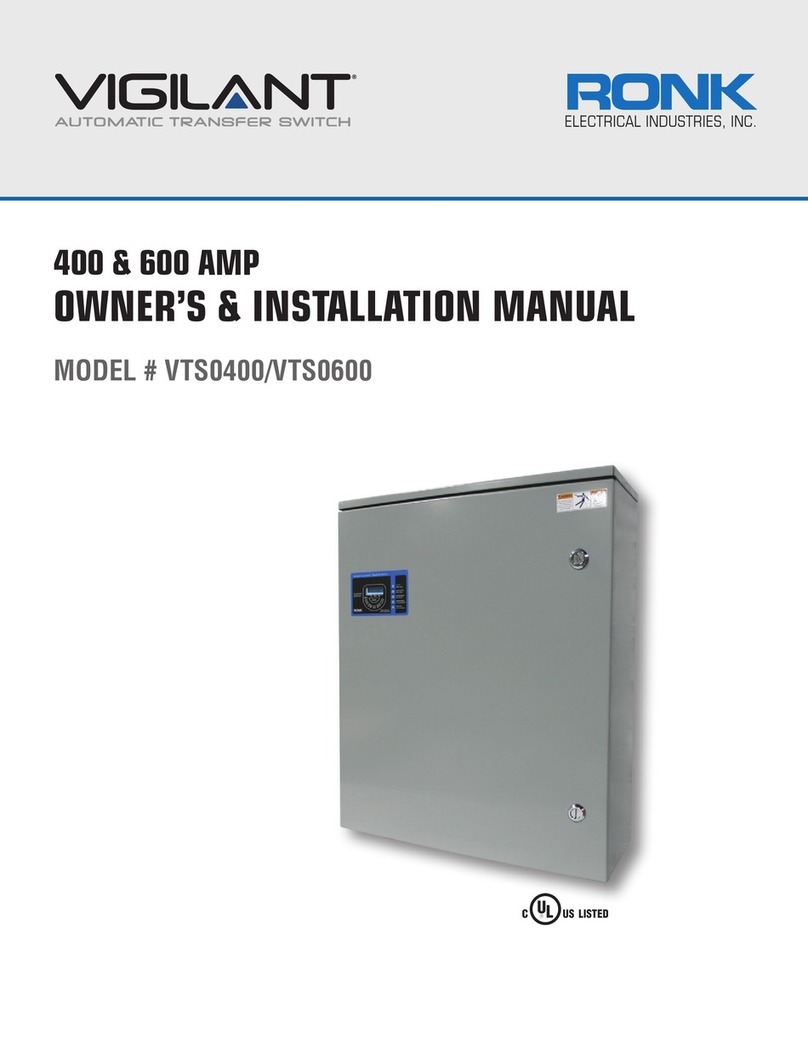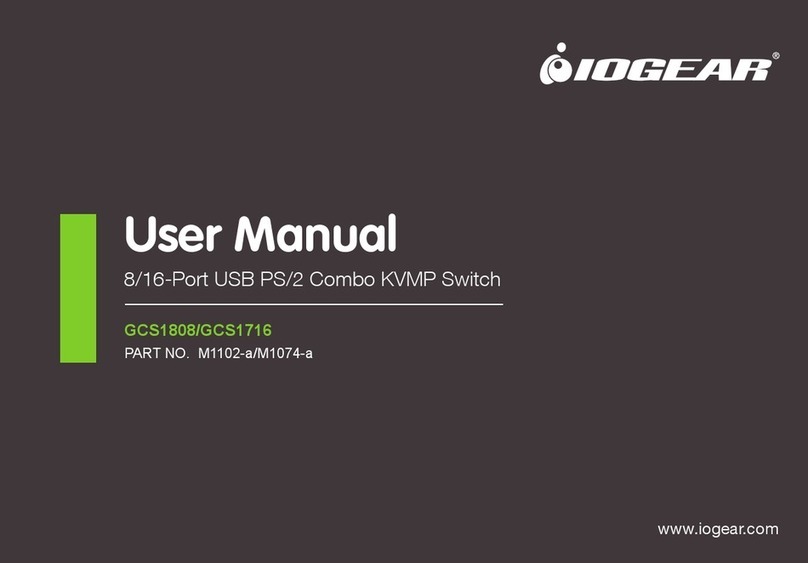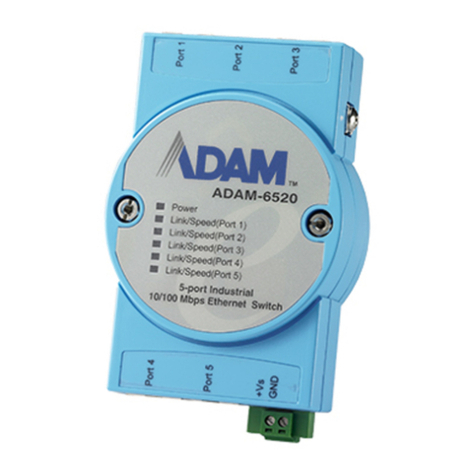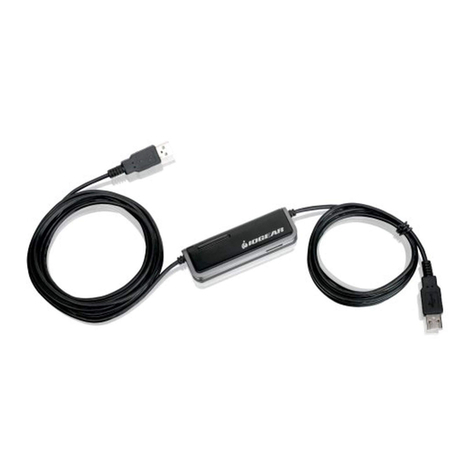RONK VIGILANT Series Quick start guide

OWNER’S & INSTALLATION MANUAL
MODEL # VTS01001240SX/VTS02001240SX
100 & 200 AMP
ELECTRICAL INDUSTRIES, INC.

2 Ronk Vigilant®Owner’s and Installation Manual
DISCLAIMERS:
All information, illustrations and specifications in this manual are based on the latest information available at the time of publishing.
The illustrations used in this manual are intended as representative reference views only. Moreover, because of our continuous product
improvement policy, we may modify information, illustrations and/or specifications to explain and/or exemplify a product, service or
maintenance improvement. We reserve the right to make any change at any time without notice. Some images may vary depending upon
which model is shown.
ALL RIGHTS RESERVED:
No part of this publication may be reproduced or used in any form by any means – graphic, electronic or mechanical, including
photocopying, recording, taping or information storage and retrieval systems – without the written permission of Ronk Electrical
Industries, Inc.
ORIGINAL INSTRUCTIONS (English):
The English version of this manual controls over any error in or conflicting interpretation of any translation.

Ronk Vigilant®Owner’s and Installation Manual 3
TABLE OF CONTENTS
INTRODUCTION ..............................................................................................................................5
Contact Information ........................................................................................................................................................... 5
Automatic Transfer Switch (ATS) ....................................................................................................................................... 5
Generator........................................................................................................................................................................... 5
SAFETY .......................................................................................................................................6
Important Safety Instructions ............................................................................................................................................ 6
Safety Symbol Meanings ............................................................................................................................................ 6
Safety Labels...................................................................................................................................................................... 7
General Safety Precautions ................................................................................................................................................ 7
SPECIFICATIONS .............................................................................................................................8
Vigilant®100A/200A Specifications ................................................................................................................................... 8
VIGILANT®PRODUCT SERIES..............................................................................................................9
Vigilant®Product Overview................................................................................................................................................ 9
Receiving, Handling and Storage ....................................................................................................................................... 9
Receiving ................................................................................................................................................................... 9
Handling ..................................................................................................................................................................... 9
Storage ....................................................................................................................................................................... 9
Vigilant®Catalog Number Identification........................................................................................................................... 10
INSTALLATION AND WIRING ............................................................................................................. 11
General Information ......................................................................................................................................................... 11
Mounting Location........................................................................................................................................................... 11
Mounting Requirements .................................................................................................................................................. 11
Recommended Upstream Protection ............................................................................................................................... 11
Power Connections.......................................................................................................................................................... 12
Lug Torque Values ........................................................................................................................................................... 12
Connections..................................................................................................................................................................... 13
GENERAL OPERATION..................................................................................................................... 14
Vigilant®Series General Operation................................................................................................................................... 14
ADJUSTMENTS AND SETTINGS.......................................................................................................... 15
Vigilant®Series Adjustments and Settings....................................................................................................................... 15
System Adjustments................................................................................................................................................. 16
Dip Switch Settings............................................................................................................................................ 16
Timing Adjustments.................................................................................................................................................. 17
Testing Adjustments ................................................................................................................................................. 18
Controller test switch......................................................................................................................................... 18
Remote test switch ........................................................................................................................................... 18
Exerciser ............................................................................................................................................................ 18
MANUAL TRANSFER....................................................................................................................... 19
Manual Transfer of Mechanism........................................................................................................................................ 19
100A/200A Manual Transfer...................................................................................................................................... 19
MAINTENANCE ............................................................................................................................. 20
Recommended Maintenance............................................................................................................................................ 20
Maintenance..................................................................................................................................................................... 20

4 Ronk Vigilant®Owner’s and Installation Manual
TABLE OF CONTENTS
DRAWINGS.................................................................................................................................. 21
VTS1001240SX/VTS02001240SX Wiring Diagram.......................................................................................................... 21
EXERCISER.................................................................................................................................. 22
Engine Exerciser and External LED Annunciation............................................................................................................. 22
Introduction .............................................................................................................................................................. 22
Clearing the Exerciser ............................................................................................................................................... 23
Set Current Time and Date........................................................................................................................................ 23
Set Program Timing.................................................................................................................................................. 23
Program Review ....................................................................................................................................................... 23
ON/AUTO/OFF Mode ................................................................................................................................................. 23
WARRANTY ................................................................................................................................. 24
Vigilant®Owner Warranty Policy...................................................................................................................................... 24
Limited Warranty ...................................................................................................................................................... 24
Warranty Period........................................................................................................................................................ 24
Warranty Registration Process ................................................................................................................................. 24
About Our Warranty.................................................................................................................................................. 24
NOTES ..................................................................................................................................... 25

Ronk Vigilant®Owner’s and Installation Manual 5
INTRODUCTION
Thank you for your purchase of a Ronk Vigilant®Series Automatic
Transfer Switch (ATS). This product is designed for use with standby
generators. This ATS may have different installation requirements
depending on the generator manufacturer or design. When operated
and maintained according to the instructions in this manual, your
system will provide many years of standby electrical energy service.
This manual contains important safety instructions for installation
and operation of this ATS. We have made every effort to provide
safe, efficient instructions for installation and operation. However,
as every installation is unique, it is impossible to anticipate every
possible procedure and method to obtain a properly installed unit.
It is important that you read and understand these instructions
thoroughly before attempting to install or operate this unit. Your
equipment is supplied with this combined Installation and User
Manual. This is an important document and should be retained
by the owner after the installation has been completed.
This ATS requires professional installation before use. Refer to the
installation section of this manual for instructions on installation
procedures. Only licensed electrical contractors should install
an ATS. Installations must comply completely with all federal,
state and local codes, standards and regulations. Your installer
should follow these instructions completely. Every effort has
been made to ensure that the information in this manual is both
accurate and current. However, the manufacturer reserves the
right to change, alter or otherwise improve the system at any time
without prior notice.
NOTICE
Please check with the generator manufacturer to ensure the
Vigilant®switch is compatible.
Contact Information
There are several ways to contact us for answers to questions you
may have about your product. Contact Technical Services
by phone at 1-217-563-8333 Monday through Friday 8 AM to
For your future reference, record the following pertinent information.
This information will help to identify product information should
you need to contact Ronk’s Technical Services department.
ATS
Model Number: ____________________________________
Description: _______________________________________
Serial Number: ____________________________________
Installation Date: ___________________________________
Generator
Model Number: ____________________________________
Description: _______________________________________
Serial Number: ____________________________________
Installation Date: ___________________________________

6 Ronk Vigilant®Owner’s and Installation Manual
SAFETY
Important Safety Instructions
Read Manufacturer’s Instructions.
SAVE THESE INSTRUCTIONS.
• This manual contains important information that should be used
during installation, maintenance and operation of this unit.
• Read all the instructions and safety symbols thoroughly before
attempting to install, operate and/or service this equipment.
Safety Symbol Meanings
Symbol Description
!
Safety Alert Symbol
Crush Hazard
Electrical Shock Hazard
!
This safety alert symbol appears with most safety
statements. It means attention, become alert, your
safety is involved! Please read and abide by the
message that follows the safety alert symbol.
!
DANGER
Indicates a hazardous situation which, if not avoided, will
result in death or serious injury.
!
WARNING
Indicates a hazardous situation which, if not avoided, could
result in death or serious injury.
!
CAUTION
Indicates a hazardous situation which, if not avoided, could
result in minor or moderate injury.
NOTICE
Indicates a situation which can cause damage to the equipment,
personal property and/or the environment, or cause the
equipment to operate improperly.
OTE:NIndicates a procedure, practice or condition that should
be followed in order for the generator to function in the
manner intended.
The manufacturer of this product cannot reasonably anticipate
every possible circumstance that might involve a hazard. The
warnings in this manual and the tags and decals affixed to the
unit are, therefore, not all-inclusive. If you use a procedure, work
method or operating technique that the manufacturer does not
specifically recommend, you must ensure that your method
is safe for you and others. You must also make sure that the
procedure, work method or operating technique that you choose
does not render the equipment unsafe.

Ronk Vigilant®Owner’s and Installation Manual 7
SAFETY
Safety Labels
Always replace any illegible or missing labels
immediately. All safety labels must be legible to alert
personnel to safety hazards.
General Safety Precautions
!
DANGER
DANGER! Equipment contains high voltage.
Despite the safe design of the system, operating
this equipment imprudently, neglecting its
maintenance or being careless can result in
death or serious injury.
!
WARNING
The safety messages that follow have WARNING
level hazards.
• Unauthorized or improper installation, operation, application
or repair of this equipment is extremely dangerous.
• Only qualified electricians should attempt installation of this
equipment, which must strictly comply with all applicable
codes, standards and regulations.
• When connecting a generator system to an electrical system
that is normally supplied by an electric utility company,
always comply with regulations of the National Electrical
Code (NEC) (Article 701 Legally Required Standby Systems
or Article 702 Optional Standby Systems, as applicable),
and Occupational Safety and Health Administration (OSHA),
as applicable. It is essential to use the latest version of any
standard to ensure all current information is applied.
!
WARNING
The safety messages that follow have WARNING
level hazards.
• Failure to properly ground equipment can result in
electrocution.
• Do not touch bare wires.
• Do not use equipment with worn, frayed, bare or otherwise
damaged wiring.
• Do not handle electrical cords while standing in water,
while barefoot, or while hands or feet are wet.
• If you must work around a unit while it is operating, stand
on an insulated dry surface to reduce shock hazard.
• Do not allow unqualified persons or children to service
equipment.
• In case of an accident caused by electrical shock,
immediately shut down all sources of electrical power
and contact local authorities. Avoid direct contact with
the victim.
• Low-voltage wire cannot be installed in the same conduit as
power voltage wiring.
• Dangerous power voltages are present inside a live ATS.
Never work on the ATS unless all power voltage supplies to
the switch have been turned off.
• When an ATS is connected to a standby generator, the
generator engine may crank and start at any time without
notice to the end user. To avoid injury that may be caused
by such start-ups, move the safety disconnect switch on
the front panel to the OFF position before working on this
equipment.
NOTICE
Improper treatment of equipment can damage it and shorten
its life.
• Use equipment only for intended uses.
• If you have questions about intended use, contact
Ronk Electrical Industries, Inc.
• Do not expose equipment to excessive moisture, dust,
dirt or corrosive vapors.
• Remain alert at all times while working on this equipment.
Never work on the equipment when you are physically or
mentally fatigued.
• If connected devices overheat, turn them off and turn off
their circuit breaker or fuse.
Figure 1

8 Ronk Vigilant®Owner’s and Installation Manual
SPECIFICATIONS
Vigilant®100A/200A Specifications
Vigilant®series transfer switches do not support Delta configurations.
UL1008 Emergency Standby rated
AC current rating 100/200A, 2-pole
AC voltage rating 120/240V
AC voltage sensing is line to neutral.1
Ambient temperature rating 113°F (45°C) at 100A/200A
131°F (55°C) at 90A/180A
149°F (65°C) at 75A/150A
158°F (70°C) at 70A/140A
Do not exceed 158°F (70°C)
RSC rating 10A maximum
DC operating voltage 12/24V DC (Voltage Range 9-30V DC)
DC power consumption 25 mA @ 12V DC
Control setting ranges Function Range Setting
Time Delay Engine Cooldown (TDEC) 0-256 seconds 256 seconds
(5.00V DC @ TP J2-1)
Time Delay Engine Start (TDES) 3-32 seconds 13 seconds
(1.56V DC @ TP J2-2)
Time Delay Normal (Utility) to
Emergency (Generator) (TDNE)
11-64 seconds 21 seconds
(0.78V DC @ TP J2-3)
Time Delay Emergency (Generator)
Transfer to Normal (Utility) (TDEN)
9-256 seconds 256 seconds
(5.00V DC@ TP J2-4)
Normal Line Sensing Under Voltage Dropout (11-18%)
Pickup (6-13%)
(±2% accuracy)
Dropout (18%)
Pickup (13%)
(±2% accuracy)
Normal Line Sensing Under Frequency 5-12%
(±1% accuracy)
12%
(±1% accuracy)
Emergency Line Sensing Under Voltage Dropout (11-18%)
Pickup (6-13%)
(±2% accuracy)
Dropout (18%)
Pickup (13%)
(±2% accuracy)
Over/under voltage sensing* Dropout (11-18%) Pickup (6-13%) adjustable
Percentage above or below normal voltage to recognize an unacceptable voltage condition (±2% accuracy).
Over/under frequency sensing 5-12% adjustable
Percentage above or below normal frequency to recognize an unacceptable frequency condition (±1% accuracy).
Exerciser timer Included
Test switch Included
UL withstand/closing ratings 22,000A with properly rated 100A circuit breaker - 480V (400A)
25,000A with properly rated 200A circuit breaker - 480V (600A)
Lug capacities 100A – 1/0 to 14 AWG
200A – 1/0 to 250 MCM
Overall dimensions 100A/Enclosure – 16 x 14 x 6 in. (40 x 35.6 x 15.2 cm) - 240
200A/Enclosure – 24 x 20 x 6 in. (61.0 x 50.8 x 15.2 cm) - 240/480
Weight 100A - 29 lb (11.3 kg), 200A - 58 lb (23.1 kg)
1One of the connected L-N phases must be below the under-voltage threshold to initiate transfer sequence.

Ronk Vigilant®Owner’s and Installation Manual 9
VIGILANT®PRODUCT SERIES
Vigilant®Product Overview
Ronk Vigilant®series automatic transfer switches are represented
by the VTS product identifier designed with all required sensing
circuitry provided. The sensing circuitry allows automatic transfer
of an electrical load to a standby power source in the event of an
over/under voltage or frequency condition on any or all phases of
the utility power source. Upon the restoration of the utility supply,
the electrical load will be automatically retransferred to the utility
power source.
All Vigilant®transfer switch mechanisms incorporate a double-
throw action switching device for automatic transferring. The
Vigilant®transfer switch mechanism is a contactor-operated
device controlled by a set of utility and generator solenoids.
Manual operation is also provided for manual transfer of the load
between the power sources if necessary.
Figure 2 – Vigilant®Series
Receiving, Handling and Storage
Shipment contents:
• Vigilant®Series – Automatic Transfer Switch
• Installation and User Manual
• Warranty card
Receiving
Every effort is made to ensure that your Vigilant®transfer switch
arrives at its destination undamaged and ready for installation.
The packing is designed to protect the transfer switch’s internal
components as well as the enclosure. Care should be taken to
protect the equipment from impact at all times. Do not remove the
protective packaging until the equipment is at the installation site
and ready to be installed.
After unpacking, inspect the switch for any damage that may
have occurred during shipping. If any missing parts or damage is
discovered when unpacking, do not return the unit to the place of
purchase; please contact Ronk Electrical for instructions on how
to proceed. Never install a switch that has been damaged.
A shipping label affixed to the shipping box includes a variety of
product and shipping information, such as items and customer
numbers. Make certain that this information matches your order
information.
Handling
As previously mentioned, each Vigilant®transfer switch is
packaged in its own individual box. Protect the equipment from
impact at all times and do not double stack. Once the transfer
switch is at the installation site and ready to be installed, the
packaging material may be removed.
Storage
Although well packaged, this equipment is not suitable for
outdoor storage. If the transfer switch is to be stored indoors
for any period of time, it should be stored with its protective
packaging in place. Protect the transfer switch at all times
from excessive moisture, dirty conditions, corrosive conditions
and other contaminants. It is strongly recommended that the
package-protected equipment be stored in a climate-controlled
environment of -4° to 149°F (-20° to 65°C), with a relative
humidity of 80% or less. Do not stack other equipment on top of
the stored switches.

10 Ronk Vigilant®Owner’s and Installation Manual
VIGILANT®PRODUCT SERIES
Vigilant®Catalog Number Identification
Figure 3
Figure 4

Ronk Vigilant®Owner’s and Installation Manual 11
INSTALLATION AND WIRING
General Information
All Vigilant®transfer switches are factory-tested and approved.
Installation requires the mounting of the transfer switch as well
as all external wiring for utility and generator operation. Once
the transfer switch is properly installed, it should be visually
inspected and approved before any testing is performed.
Mounting Location
IMPORTANT: Vigilant®series transfer switches do not
support Delta configurations.
!
WARNING
Always use adequate lifting to lift and mount the
transfer switch during installation.
All Vigilant®transfer switches require that adequate lifting
means are used to install the switch at its mounting location.
Be certain to choose a location that offers a flat mounting
surface that is capable of supporting the transfer switch (see
Vigilant®100A/200A Specifications on page 8 for proper
weight details). Caution must be taken at the installation site to
make sure the site is free from excessive moisture, fluctuating
temperature ranges, dust, corrosive materials, etc. Before any
drilling takes place, be certain the drilling area is free of any
hazards including electrical wiring, piping, etc. Extreme caution
should be exercised when any installation and drilling are
performed to protect the transfer switch from any debris including
contaminants, filings, etc. Any debris within the transfer switch
may result in a system malfunction.
Mounting Requirements
The enclosure has a NEMA (National Electrical Manufacturer’s
Association) type 3R rating and is suitable for indoor/outdoor
installations and provides a degree of protection against falling
rain and sleet. Guidelines for mounting the unit include:
• Ensure that the mounting surface can support the weight of
the switch and adheres to all local codes.
• The enclosure must be installed with NEMA type 3R hardware
and connections.
• Level and plumb the unit enclosure to prevent deformation.
• Never install the switch where any corrosive substance may
come in contact with the enclosure.
• Protect the switch at all times against excessive moisture, dust,
dirt, lint, construction grit and corrosive vapors.
Recommended Upstream Protection
When protected by a circuit breaker rated at 100A maximum
for 100A rated transfer switches, this switch is suitable for use
on a circuit capable of delivering not more than 22,000A RMS
SYMMETRICAL AT 240V.
When protected by a circuit breaker rated at 200A maximum
for 200A rated transfer switches, this switch is suitable for use
on a circuit capable of delivering not more than 25,000A RMS
SYMMETRICAL AT 240V.
Use copper or aluminum wiring 60/75C rating for power
terminals.
!
CAUTION
Using upstream protection devices other than the circuit
breakers with the recommended ratings given above may
cause improper operation of the Vigilant®switch.
!
WARNING
Always de-energize power connections before
installing any connections. Power lines may
carry high voltage. Exercise extreme caution
when installing any power connections to the
Vigilant®switch.

12 Ronk Vigilant®Owner’s and Installation Manual
INSTALLATION AND WIRING
Power Connections
Proper power cables need to be installed to the transfer switch
and should be installed by licensed electrical contractors.
Improper installation or connections of these power cables are
extremely dangerous and may cause severe injury or death. All
power connections are to be connected to the proper lugs, which
are included on the switch contactor and neutral block assembly.
Connect the utility, generator, neutral and load cables to the
terminals, which are clearly marked on the transfer switch (see
Figure 5). Verify that all connections are correct before tightening
lugs. All power cable lug connections must be tightened to the
proper torque values as shown in Table 1 and Table 2.
!
WARNING
Low-voltage wire cannot be installed in the same
conduit as power voltage wiring. It could result
in shock due to short circuit as well as cause
electromagnetic interference resulting in
non-operation of the system.
Figure 5 – Power Cable Connection Locations
!
WARNING
Always install the transparent protective shields
covering the power connections of the switch
mechanism once the proper connections are
performed.
Lug Torque Values
Table 1: 100A Lug Torque Values
AWG or Circular
Mill Size
Tightening Torque
Screw Driver External Drive Wrench
14 35 75
12 35 75
10 35 75
8 40 75
6 45 110
4 45 110
2 50 150
1 50 150
1/0 50 180
Wire size range 1/0-14 AWG copper, 1/0-12 AWG aluminum using
Ilsco lug # CA5-SP
Table 2: 200A Lug Torque Values
Internal Socket Size
Across Flats Tightening Torque
5/16 in. (7.93 mm) 275 in-lb (31 N·m)
Wire size range 250 kcmil-6 AWG copper or aluminum using Ilsco
lug # CA6-RP

Ronk Vigilant®Owner’s and Installation Manual 13
INSTALLATION AND WIRING
Connections
Battery +
Battery -
Transfer Switch
(Internal)
Generator
SPST
(Optional)
12/24VDC
+-
N.O. dry contacts
Remote Start
Contacts –To
Generator
Generator Battery
Figure 6
Figure 7
OTE:NThe transfer switch consists of the 6-position terminal
block (shown in Figure 6) for connections.
Battery + and Battery – must be connected for operation of the
VTSC100 controller. The battery is either 12V DC or 24V DC. A
1A fuse should be placed on the Battery + connection. Do not use
an isolated power supply to power the controller as the controller
requires a reference to neutral for AC sensing, which it obtains
from the distribution system via Battery -.
RSC1 and RSC2 need to be connected to the remote start/stop
connections of the generator to allow automatic starting. These
are N.O. dry contacts.
An optional customer-supplied test switch may be installed by the
customer using the TEST 1 and TEST 2 terminals. A closed circuit
between the test connections will simulate a utility failure. See
wiring diagram for details.
The battery charger needs to be of high quality. Low-quality
battery chargers will often go into full recharge mode due to VTS2
controller current draw. This will quickly wear out the battery.

14 Ronk Vigilant®Owner’s and Installation Manual
GENERAL OPERATION
Vigilant®Series General Operation
The Vigilant®switch in combination with the control board timing
module will allow for the automatic transfer of an electrical
load to a standby power source in the event of an over/under
voltage or frequency condition on any or all phases of the utility
power supply.
In the event of an over/under voltage or frequency condition of
utility power, the onboard control board sensing circuitry will
begin the initiation of the transfer process. Upon initial sensing of
a loss of utility power, the Vigilant®transfer switch is specifically
designed to allow an engine start time delay period (TDES) to
expire before starting the generator. This engine start time delay
is user-adjustable from the VTSC100, preventing unnecessary
engine starts from a temporary loss of utility. In the event the
utility source is not restored after the engine start time delay has
expired, the remote contacts will close, sending a signal to the
generator’s automatic start controller.
When the control board senses that the generator has started,
and is within acceptable limits, the transfer switch will wait until
the utility to generator time delay (TDNE) has expired before
switching to the generator position. All connected loads will be
transferred to the generator power source.
While the transfer switch is in the generato position, the control
board will constantly monitor the utility source voltage and
frequency status. Once the utility source is restored, the transfer
switch will wait until the generator to utility time delay (TDEN) has
expired before switching back to the utility position. All connected
loads are transferred to the utility power source.
When connected loads are transferred back to the utility power
source, an engine cooldown period (TDEC) will be initiated,
allowing the generator to run in a no-load condition. This engine
cooldown time delay is user-adjustable from the control board,
allowing the generator to continue running for an adjustable
period after the utility is restored.

Ronk Vigilant®Owner’s and Installation Manual 15
ADJUSTMENTS AND SETTINGS
Vigilant®Series Adjustments and Settings
!
DANGER
Never adjust settings on the transfer switch
controller while the controller is energized.
Always completely isolate all power sources from
the controller and transfer switch mechanism
before making any adjustments.
The Vigilant®series adjustments and settings may be made from
the onboard transfer switch controller. The general settings and
adjustments are as follows.
Figure 8
12/24 VDC OPERATION
The control board is designed to operate in a 12 OR 24 VDC
system voltage.
In 12VDC system operation, the controller requires that jumpers
be installed in the 12/24VDC jumper location.
In 24VDC system operation, the controller requires that no
jumpers be installed in the 12/24VDC jumper location.
A total of five jumpers need to be installed for 12VDC operation
as illustrated.
Installing jumpers in the 12/24 VDC jumper locations for 24VDC
system operation may damage the control board.
Jumper
installed
for 12VDC
Jumper
Jumper
Jumper
Jumper
Jumper
Jumper
Jumper
Jumper
Jumper not
installed
for 24VDC
Jumper
Jumper
Jumper not
installed
for 24VDC
Jumper
installed
for 12VDC Relay (RSC)
TDEC TDES
12/24VDC
Jumper
Location
1
LED Annuciator
Dip Switch
1
ON 2 3 4 5 6 7 8 9
Adjustable
Pots
Figure 9 – 12/24 VDC Operation

16 Ronk Vigilant®Owner’s and Installation Manual
ADJUSTMENTS AND SETTINGS
System Adjustments
Table 3: Dip Switch Settings
Feature Switch Settings
Set Function Set Function Set Function Set Function Set Function Set Function Set Function Set Function
1
Keep in OFF
position at
all times
OFF – OFF – – – – – – – – – – – – –
2*
Set the unit
for 50/60Hz
systems
ON 60 Hz OFF 50 Hz – – – – – – – – – – – –
3*
Weekly
exercise
with load/no
load
ON
Load
test
cycle
OFF
No load
test
cycle
– – – – – – – – – – – –
4Set the
over/under
voltage
setting
OFF Dropout
v 18%
Pickup v
13%
OFF Dropout
v 17%
Pickup v
12%
OFF Dropout
v 16%
Pickup v
11%
OFF Dropout
v 15%
Pickup v
10%
ON Dropout
v 14%
Pickup v
9%
ON Dropout
v 13%
Pickup v
8%
ON Dropout
v 12%
Pickup v
7%
ON Dropout
v 11%
Pickup v
6%
5 OFF OFF ON ON OFF OFF ON ON
6 OFF ON OFF ON OFF ON OFF ON
7Set the
over/under
frequency
setting
OFF
12%
OFF
11%
OFF
10%
OFF
9%
ON
8%
ON
7%
ON
6%
ON
5%8 OFF OFF ON ON OFF OFF ON ON
9 OFF ON OFF ON OFF ON OFF ON

Ronk Vigilant®Owner’s and Installation Manual 17
ADJUSTMENTS AND SETTINGS
Timing Adjustments
5A
10A
Relay (RSC)
Test Point
TDEC TDES TDNE TDEN
Test
Normal
Test
Switch
12/24VDC
Jumper
Location
5-Position
Connector
1
1
1 5
5
LED Annuciator
Dip Switch
1
ON 2 3 4 5 6 7 8 9
Adjustable
Pots
Figure 10
Table 4:
POT ID Description
TDEC Time Delay Engine Cool: This delay allows the engine to continue running after the transfer switch returns to the normal (utility) position. When
the control board recognizes that the transfer switch is in the normal (utility) position after an emergency generator) to normal (utility) transfer, the
generator will continue to run under a no-load condition until the engine cool time delay has expired.
TDES Time Delay Engine Start: This delay prevents unnecessary engine starts. When the control board determines a utility failure, it will wait for the
Engine start time delay to expire before trying to start the generator
TDNE Time Delay Normal (utility) to Emergency (Generator): This delay allows the generator to stabilize before any load is transferred. This normal
(utility) to emergency (generator) time delay allows the generator to be fully running before supplying power to a load.
TDEN Time Delay Emergency (Generator) to Normal (utility): This delay allows the utility source to be monitored for stability. This emergency (generator)
to normal (utility) time delay allows the utility to be monitored for the set amount of time to confirm that it is fully restored and stable

18 Ronk Vigilant®Owner’s and Installation Manual
ADJUSTMENTS AND SETTINGS
Testing Adjustments
Controller test switch
Test
Utility/Normal
Manual testing of the Vigilant®transfer switches may be achieved
by manual adjustment of the test switch located on the control
board. The controller test switch will allow manual testing of the
transfer switch. The purpose of the test switch is to simulate a
utility power failure. Normally the test switch would be set to the
utility position, allowing proper sensing for normal utility faults.
To simulate a utility fault when no fault actually exists, the test
switch would be set to the test position, allowing the transfer
switch to transfer to the generator position. After testing, utility
power can be restored simply by setting the test switch back to
the utility position.
Remote test switch
The remote test switch will allow remote testing of the transfer
switch. The purpose of the test switch is to simulate a utility
power failure. The remote test switch may be installed by a
licensed electrical contractor; the switch would be installed at
the TEST 1 and TEST 2 on the terminal block. Normally the test
switch would be set to the DISABLE position, allowing proper
sensing for normal utility faults. To simulate a utility fault when
no fault actually exists, the test switch would be set to the
ENABLE position, allowing the transfer switch to transfer to the
generator position. A SPST test switch rated at a minimum of 1A
should be used.
Exerciser
The purpose of the exerciser is to perform a test of the transfer
switch either manually or automatically. The exerciser may be
adjusted by a licensed electrical contractor to any specific time
or day in which to perform a test. The exerciser can perform a
test for a load or no-load condition. For details instructions on
operational and setting instructions, see ENGINE EXERCISER
AND EXTERNAL LED ANNUNCIATION on page 22.

Ronk Vigilant®Owner’s and Installation Manual 19
MANUAL TRANSFER
Manual Transfer of Mechanism
!
WARNING
Never perform a manual transfer while the
transfer switch is under load. Manual transfer is
not recommended. If performing an emergency
manual transfer, be certain to isolate the transfer
switch from all power and load sources.
Manual transferring is not recommended. If the transfer switch
fails to transfer in an emergency, an optional manual transfer
may be performed. Caution must be taken to confirm that the
transfer switch is isolated from all possible load sources before
transferring. Please note the flat side of the removable handle
must face away from the power connection side of the switch
mechanism as seen in Figure 12 for easy transferring. Always
remove the handle from the manual transfer handle lever location
after each transfer.
100A/200A Manual Transfer
In 100 and 200A transfer switches, the manual transfer lever
located on the contactor is used to manually transfer between the
utility and generator position. With the lever facing up toward the
normal side, the switch will be in the normal position. With the
lever down facing toward the emergency side, the switch will be in
the emergency position.
!
WARNING
Never allow the removable lever handle to come
in contact with live wires or terminals.
Figure 11 – Removable Lever Handle
Figure 12 – Manual Transfer Lever Location

20 Ronk Vigilant®Owner’s and Installation Manual
MAINTENANCE
RECOMMENDED MAINTENANCE
!
WARNING
Always isolate the transfer switch from all
possible power sources when performing
maintenance on the mechanism.
Periodically inspect all terminals (load, line and control) and all
fasteners for any loose parts or wiring.
Periodically inspect all terminals (load, line and control) and all
fasteners for tightness.
Test the transfer switch operation upon initial installation.
Periodically check for any excessive wear on any mechanical
operating parts or wiring connections. Clean or replace parts when
necessary.
All transfer switch parts are made of corrosion-resistant material
or are plated, coated or painted for corrosion protection.
Table 7:
Procedure Action
Make the transfer switch safe for inspection and maintenance Disconnect all possible power sources before switch inspection.
Inspect the transfer switch location for possible safety hazards Inspect mounting location for any safety or fire hazards. Inspect for dirt, wiring damage and
mechanical damage.
Inspect the transfer switch for loose hardware Check all hardware including controller, exerciser, terminals, etc. for any looseness due to
vibrations, etc.
Check for any overheating due to loose connections Check for any discoloration, melting or blistering of wiring or connections.
Perform regular testing of the transfer switch Perform regular testing of the switch to check for proper operation in case of emergency.
Maintenance
Always maintain a 3 feet (92 cm) clearance around the Vigilant®
transfer switch. Once a month, visually inspect the outside of the
switch for accumulation of dirt, moisture and/or corrosion on the
enclosure.
The homeowner or end user is responsible for following all
maintenance and periodic testing procedures and guidelines of the
generator owner’s manual to ensure proper operation.
Once a year, have a licensed electrician clean the inside of the
switch and inspect for:
• Damage or loose parts
• Discoloration of wire insulation or components
This manual suits for next models
2
Table of contents
Other RONK Switch manuals
Popular Switch manuals by other brands
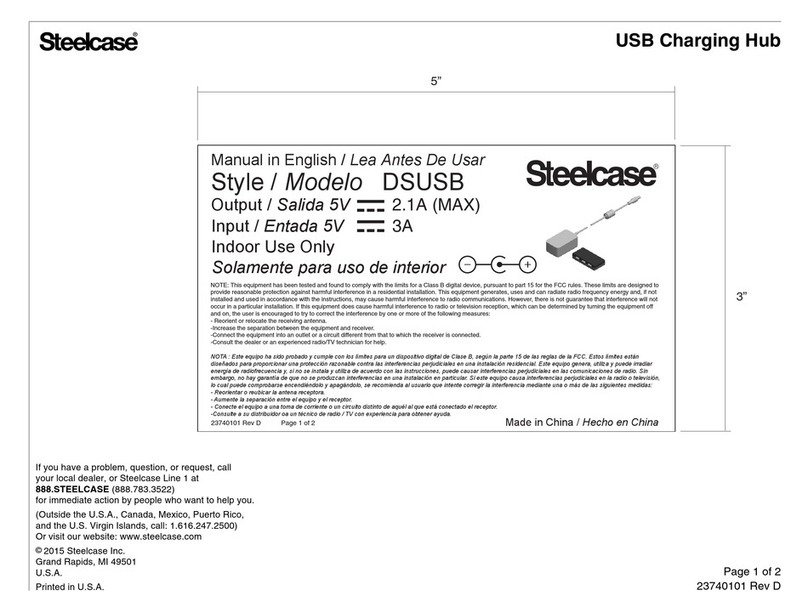
Steelcase
Steelcase DSUSB manual
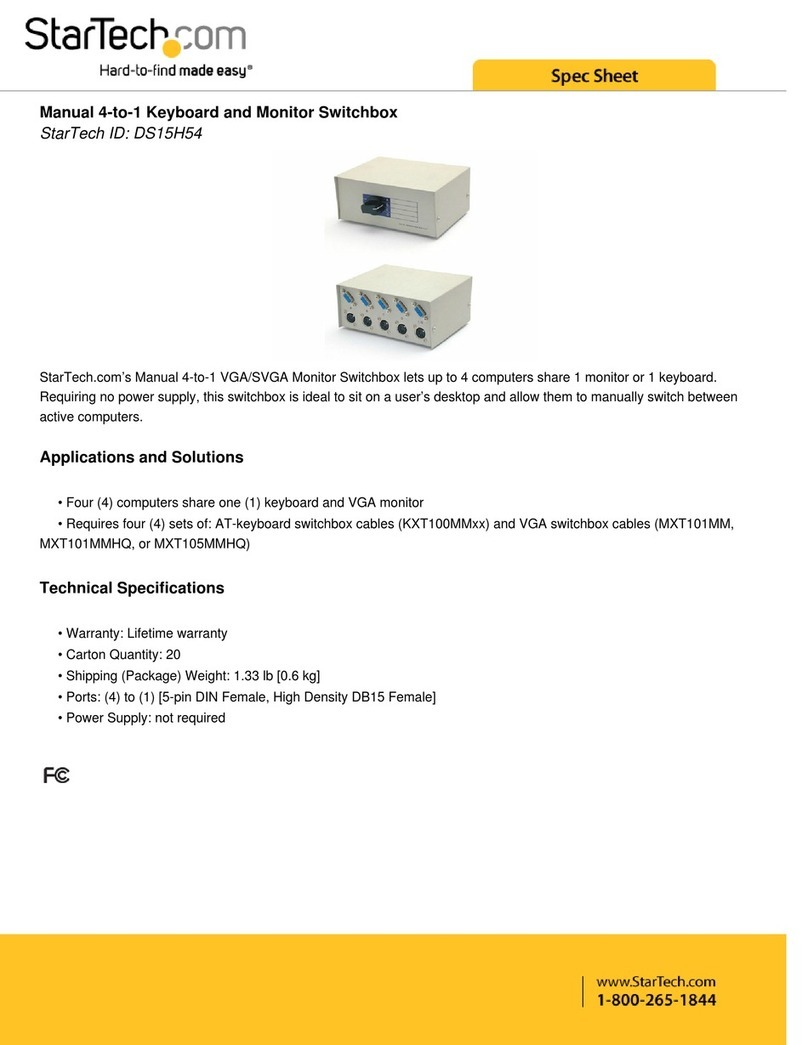
StarTech.com
StarTech.com DS15H54 Spec sheet
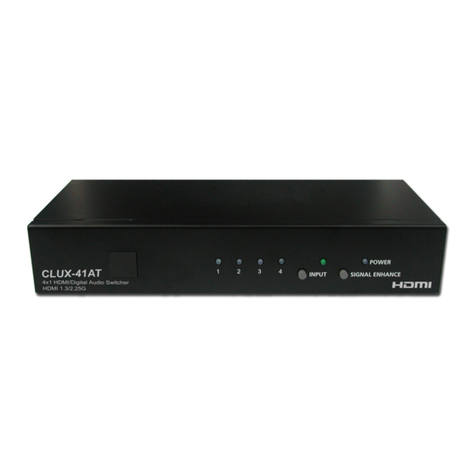
CYP
CYP CLUX-41AT Operation manual
Harris
Harris IconMaster Installation and configuration manual

Speaka Professional
Speaka Professional 1629555 operating instructions

Extreme Networks
Extreme Networks 59100 Series Quick install guide
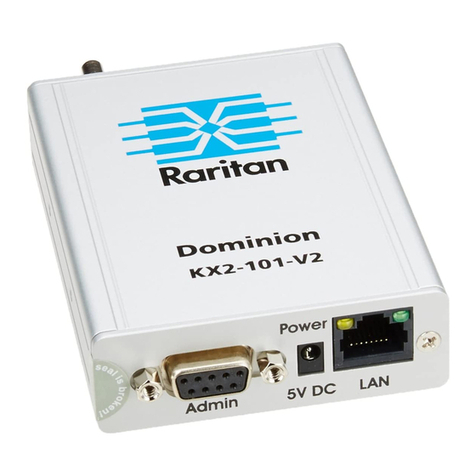
Raritan
Raritan Dominion KX II-101-V2 user guide
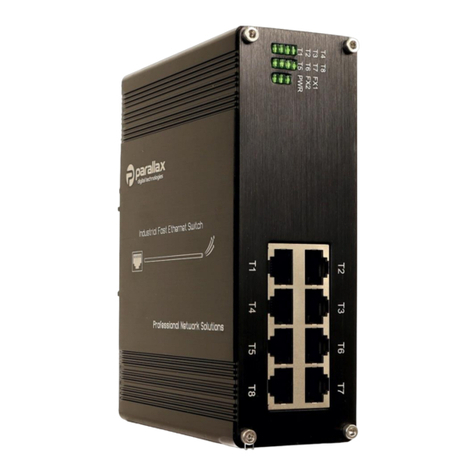
Parallax
Parallax PDT-NSU-0008-MP-I Operation manual
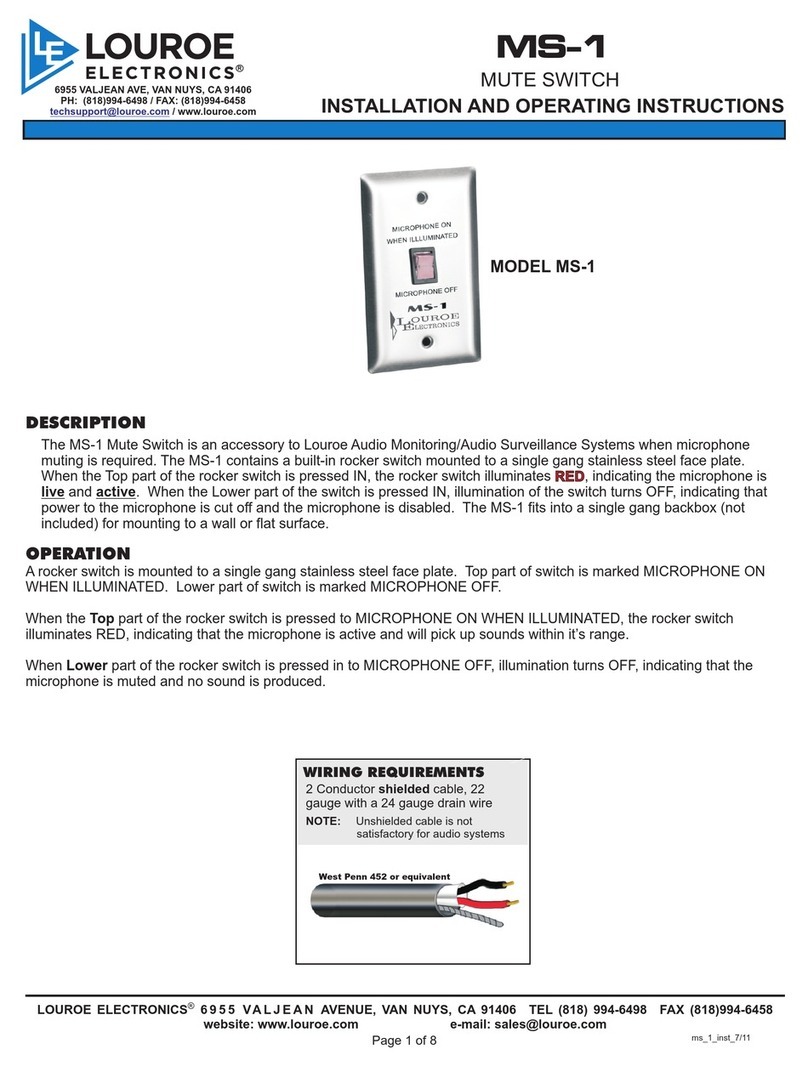
Louroe Electronics
Louroe Electronics MS-1 Installation and operating instructions
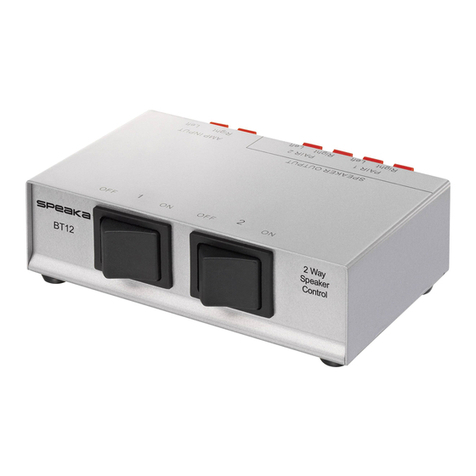
Speaka Professional
Speaka Professional 1285755 operating instructions
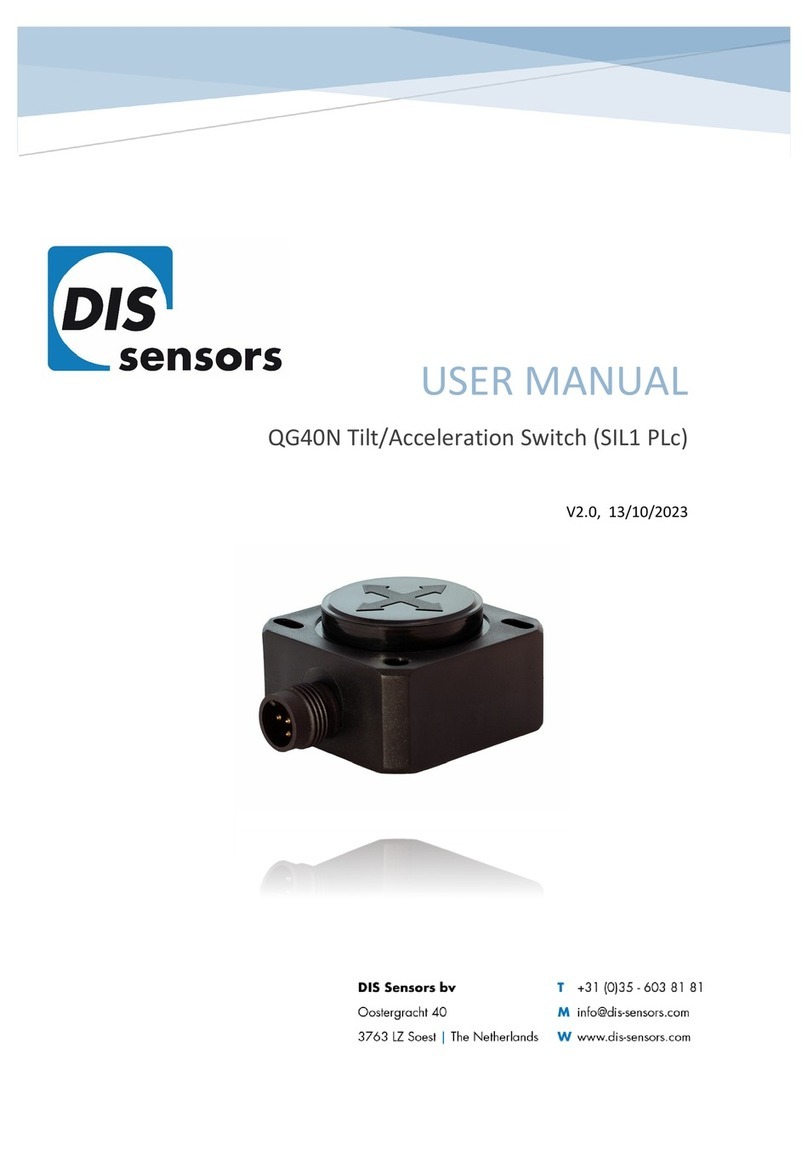
DIS Sensors
DIS Sensors QG40N user manual

PTN
PTN WVG2AL USB user manual

